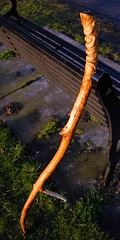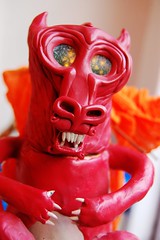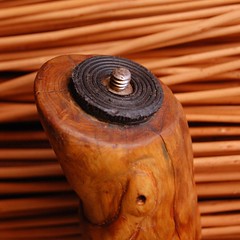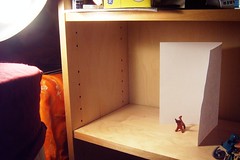Monopod staff
 I found my staff as driftwood on the beach at Helensburgh, the morning after spending a night in a police cell for protesting at the nuclear base Faslane.
I found my staff as driftwood on the beach at Helensburgh, the morning after spending a night in a police cell for protesting at the nuclear base Faslane.
I took it home, flaked off what was left of its bark, sawed off the rough ends and sanded it down. Then I stained it slightly with tea, and once it had fully dried I rubbed linseed oil in to preserve it, to bring out the colour and to give it a slight sheen.
 Later I mounted a screw in the top so that I could use it as a monopod. This would hold my camera still on the top, or indeed anything else there that has the same kind of thread as a camera – a 1/4″ Whitworth thread, which turns out to be incredibly hard to find in Britain, where all the nuts and bolts went metric years ago. I made a dragon with glowing eyes, about 6″ tall, to place on top.
Later I mounted a screw in the top so that I could use it as a monopod. This would hold my camera still on the top, or indeed anything else there that has the same kind of thread as a camera – a 1/4″ Whitworth thread, which turns out to be incredibly hard to find in Britain, where all the nuts and bolts went metric years ago. I made a dragon with glowing eyes, about 6″ tall, to place on top.
My first attempt just involved drilling a hole and mounting a bare, topless bolt in it using epoxy putty. This turned out to be a mistake – the mounting needs to be strong enough to withstand repeated screwing and unscrewing, and this wasn’t, leading to my camera falling off and breaking slightly when someone jostled against me one night.
 My second attempt used the camera screw and its plastic mounting from a monopod walking-stick I bought, whose manufacturers had made much the same mistake as me – it was originally attached to a feeble piece of plastic that broke almost immediately after I bought it; I took it back, got it replaced, and the second time, with great care, it lasted about a week. Still, the remaining mounting was sturdy enough, and with a large drill I made a hole in the top of my staff just big enough to accommodate it, and fixed it in place once more with epoxy putty. It has held ever since. The curve of the staff makes it easy to spin around in order to screw and unscrew it.
My second attempt used the camera screw and its plastic mounting from a monopod walking-stick I bought, whose manufacturers had made much the same mistake as me – it was originally attached to a feeble piece of plastic that broke almost immediately after I bought it; I took it back, got it replaced, and the second time, with great care, it lasted about a week. Still, the remaining mounting was sturdy enough, and with a large drill I made a hole in the top of my staff just big enough to accommodate it, and fixed it in place once more with epoxy putty. It has held ever since. The curve of the staff makes it easy to spin around in order to screw and unscrew it.
 Last year I realised that the staff would make a much more comfortable walking stick if it had finger-grips, so I started carving some into it. After I had been at it for a while I realised that the knot just above the grips I was carving looked a bit like an eye, and the snake design naturally followed.
Last year I realised that the staff would make a much more comfortable walking stick if it had finger-grips, so I started carving some into it. After I had been at it for a while I realised that the knot just above the grips I was carving looked a bit like an eye, and the snake design naturally followed.
 It’s not easy to tell what kind of tree driftwood comes from, in general, but based on the opinion of a professional wood-worker I met, I think my staff is made of yew – the density of little knots suggests an evergreen, while weight and strength of the wood rule out most other varieties of softwood. I use the staff for hiking, supporting my weight when I have a leg injury, and as a monopod. It is so strong that despite its curve, it can hold my entire weight.
It’s not easy to tell what kind of tree driftwood comes from, in general, but based on the opinion of a professional wood-worker I met, I think my staff is made of yew – the density of little knots suggests an evergreen, while weight and strength of the wood rule out most other varieties of softwood. I use the staff for hiking, supporting my weight when I have a leg injury, and as a monopod. It is so strong that despite its curve, it can hold my entire weight.
